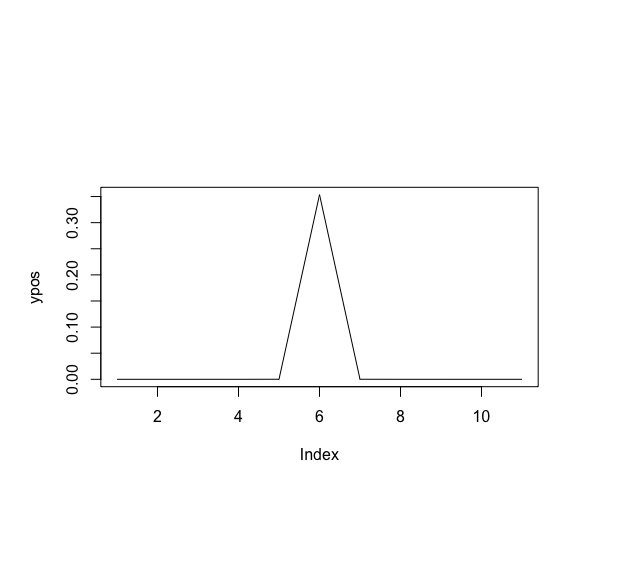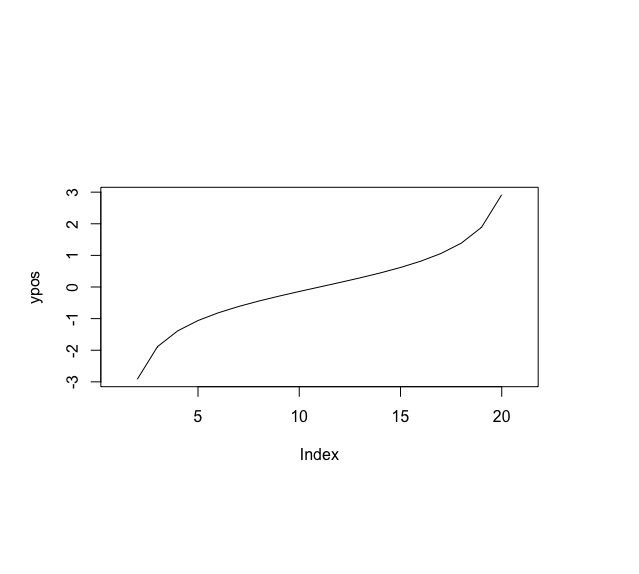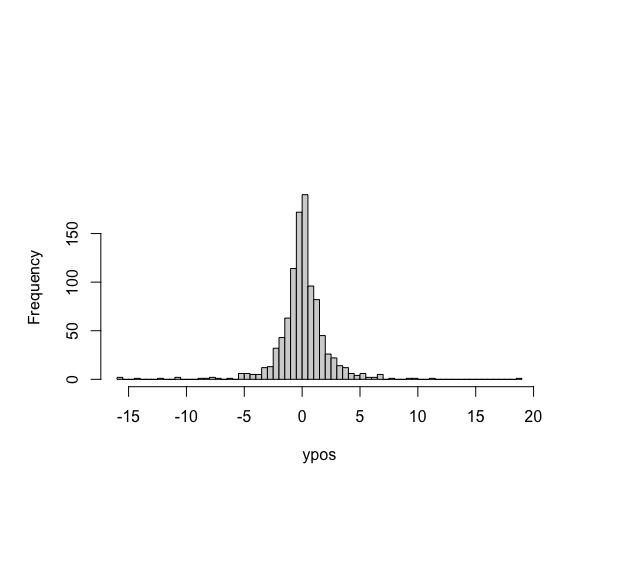在 R 中绘制 t 分布
t 分布,也称为学生 t 分布,是一种概率分布,用于对样本量很小且输入分布的标准偏差未知的正态分布进行抽样。分布通常形成钟形曲线,即分布呈正态分布,但峰值较低,尾部附近的观测值较多。
t 分布只有一个相关参数,称为自由度 (df)。特定 t 分布曲线的形状取决于所选的自由度 (df) 的数量,该数量等于给定的样本量减 1,即,
df=n−1可以使用 R 中的 seq() 方法生成坐标向量,该方法用于生成整数的增量序列,为给定的 t 分布提供分布序列。可以使用下面详述的 t 分布函数的各种变体来构建相应的 y 坐标。然后使用 R 编程语言中的 plot() 方法绘制这些图。
dt() 方法
R 中的 dt() 方法用于计算具有指定自由度的 t 分布的概率密度分析。
Syntax:
dt(x, df )
Parameter :
- x – vector of quantiles
- df – degrees of freedom
例子:
R
# generating x coordinates
xpos <- seq(- 100, 100, by = 20)
print ("X coordinates")
print (xpos)
# generating y coordinates using dt() method
# degreesoffreedom
degree <- 2
ypos <- dt(xpos, df = degree)
print ("Y coordinates")
print (ypos)
# plotting t distribution
plot (ypos , type = "l")R
# generating x coordinates
xpos <- seq(- 100, 100, by = 20)
print ("X coordinates")
print (xpos)
# generating y coordinates using dt() method
# degreesoffreedom
degree <- 2
ypos <- pt(xpos, df = degree)
print ("Y coordinates")
print (ypos)
# plotting t distribution
plot (ypos , type = "l")R
# generating x coordinates
xpos <- seq(0, 1, by = 0.05)
# generating y coordinates using dt() method
# degreesoffreedom
degree <- 2
ypos <- qt(xpos, df = degree)
# plotting t distribution
plot (ypos , type = "l")R
# using a random number
n <- 1000
# degreesoffreedom
degree <- 2
# generating y coordinates using rt() method
ypos <- rt(n , df = degree)
# plotting t distribution in the form of
# distribution
hist(ypos,
breaks = 100,
main = "")输出
[1] “X coordinates”
[1] -100 -80 -60 -40 -20 0 20 40 60 80 100
[1] “Y coordinates”
[1] 9.997001e-07 1.952210e-06 4.625774e-06 1.559575e-05 1.240683e-04 [6] 3.535534e-01 1.240683e-04 1.559575e-05 4.625774e-06 1.952210e-06
[11] 9.997001e-07

pt() 方法
R 中的 pt() 方法用于为给定的学生 T 分布生成分布函数。它用于产生累积分布函数。此函数返回任何给定间隔的 t 曲线下的面积。
Syntax:
pt(q, df, lower.tail = TRUE)
Parameter :
- q – quantile vector
- df – degrees of freedom
- lower.tail – if TRUE (default), probabilities are P[X ≤ x], otherwise, P[X > x].
例子:
电阻
# generating x coordinates
xpos <- seq(- 100, 100, by = 20)
print ("X coordinates")
print (xpos)
# generating y coordinates using dt() method
# degreesoffreedom
degree <- 2
ypos <- pt(xpos, df = degree)
print ("Y coordinates")
print (ypos)
# plotting t distribution
plot (ypos , type = "l")
输出
[1] “X coordinates”
[1] -100 -80 -60 -40 -20 0 20 40 60 80 100
[1] “Y coordinates”
[1] 4.999250e-05 7.810669e-05 1.388310e-04 3.122073e-04 1.245332e-03 [6] 5.000000e-01 9.987547e-01 9.996878e-01 9.998612e-01 9.999219e-01
[11] 9.999500e-01

qt() 方法
R 中的 qt() 方法用于计算指定数量自由度的给定 t 分布的分位数函数或逆累积密度函数。它用于计算具有指定自由度的学生 t 分布的第 n 个百分位数。
Syntax:
qt(p, df, lower.tail = TRUE)
Parameter :
- p – vector of probabilities
- df – degrees of freedom
- lower.tail – if TRUE (default), probabilities are P[X ≤ x], otherwise, P[X > x].
例子:
电阻
# generating x coordinates
xpos <- seq(0, 1, by = 0.05)
# generating y coordinates using dt() method
# degreesoffreedom
degree <- 2
ypos <- qt(xpos, df = degree)
# plotting t distribution
plot (ypos , type = "l")
输出

rt() 方法
rt() 方法用于使用指定数量的自由度随机生成 t 分布。可以生成 n 个随机样本。
Syntax:
rt(n, df)
Parameter :
- n – number of observations
- df – degrees of freedom
例子:
电阻
# using a random number
n <- 1000
# degreesoffreedom
degree <- 2
# generating y coordinates using rt() method
ypos <- rt(n , df = degree)
# plotting t distribution in the form of
# distribution
hist(ypos,
breaks = 100,
main = "")
输出
